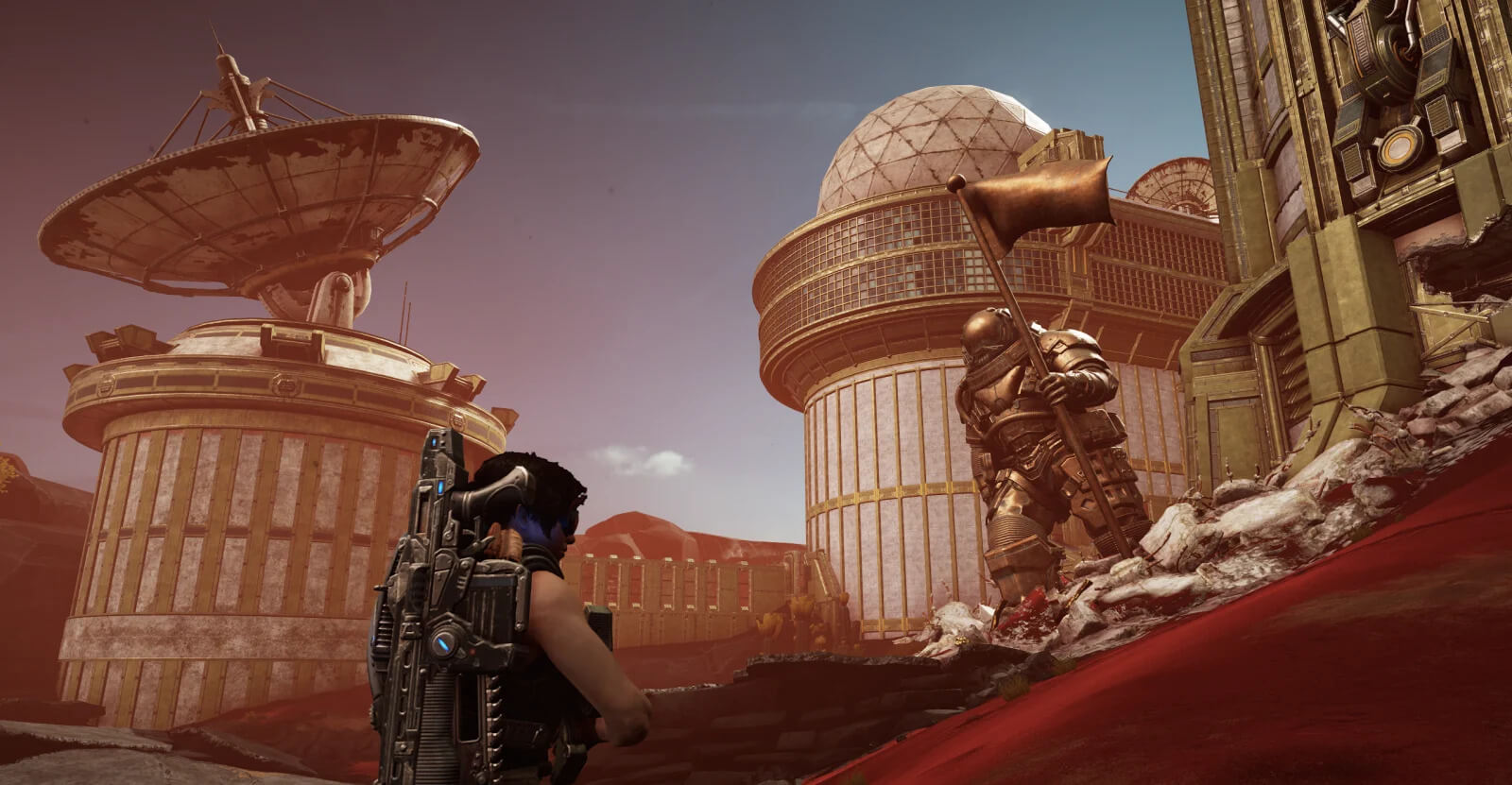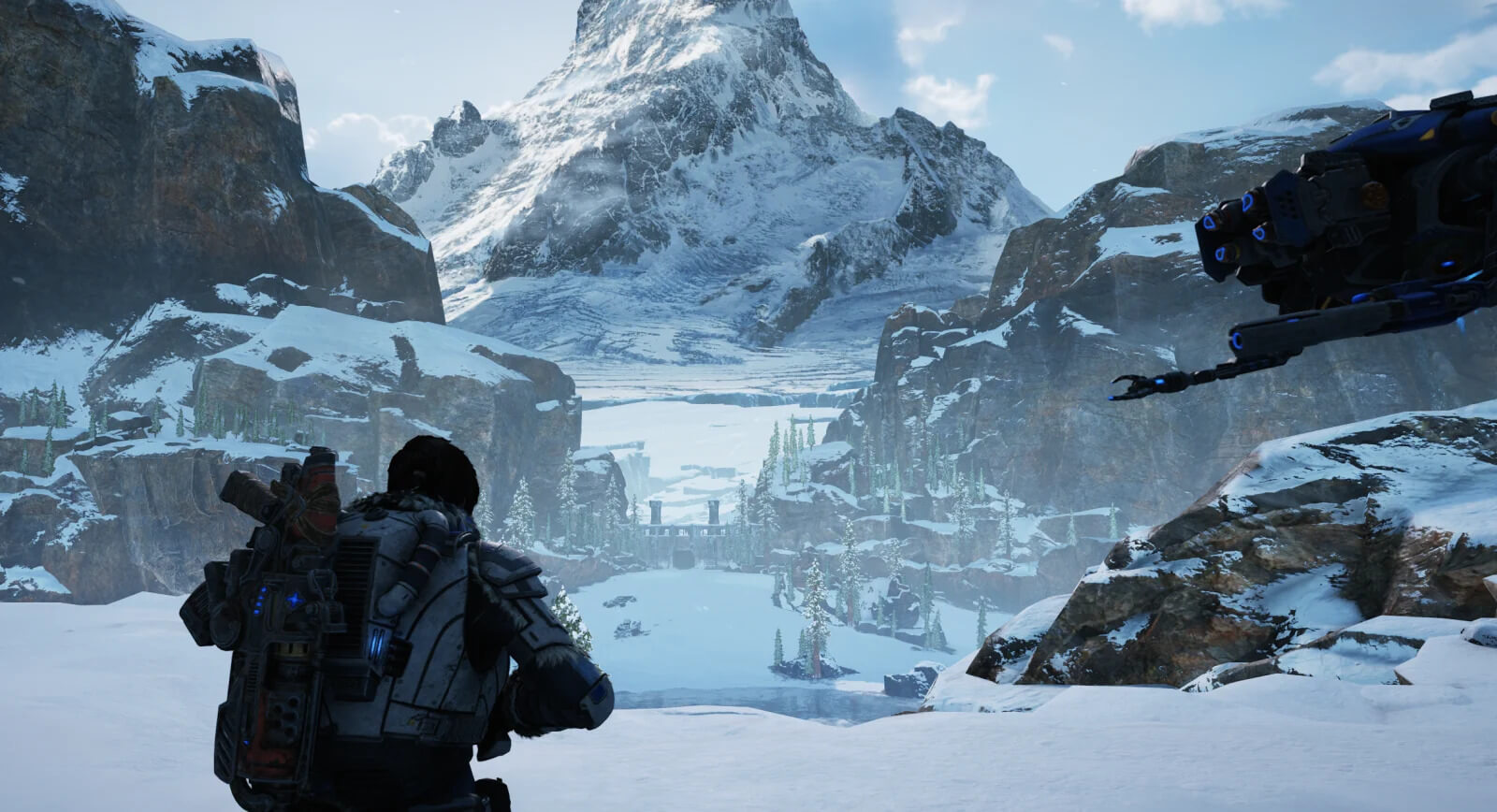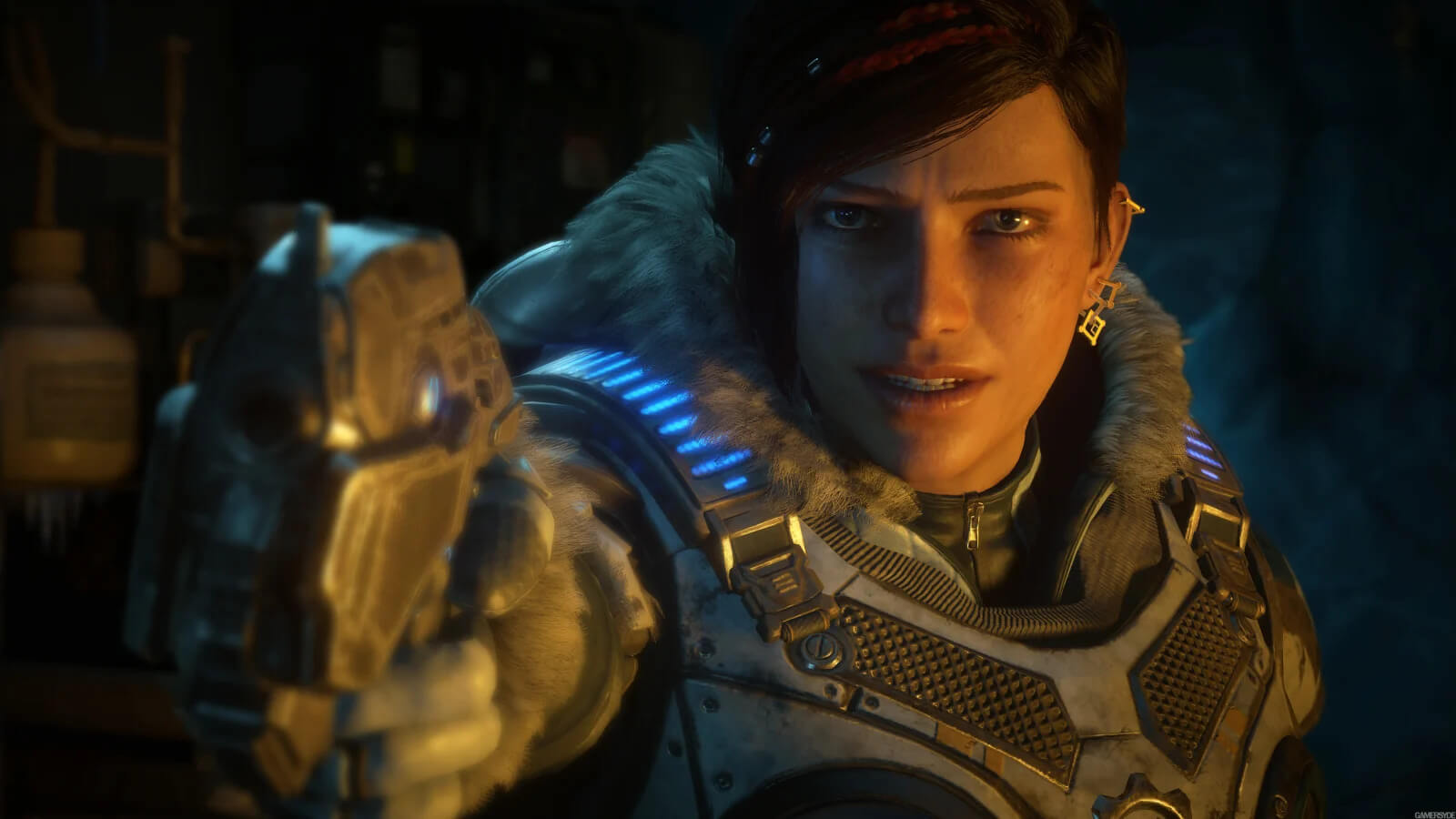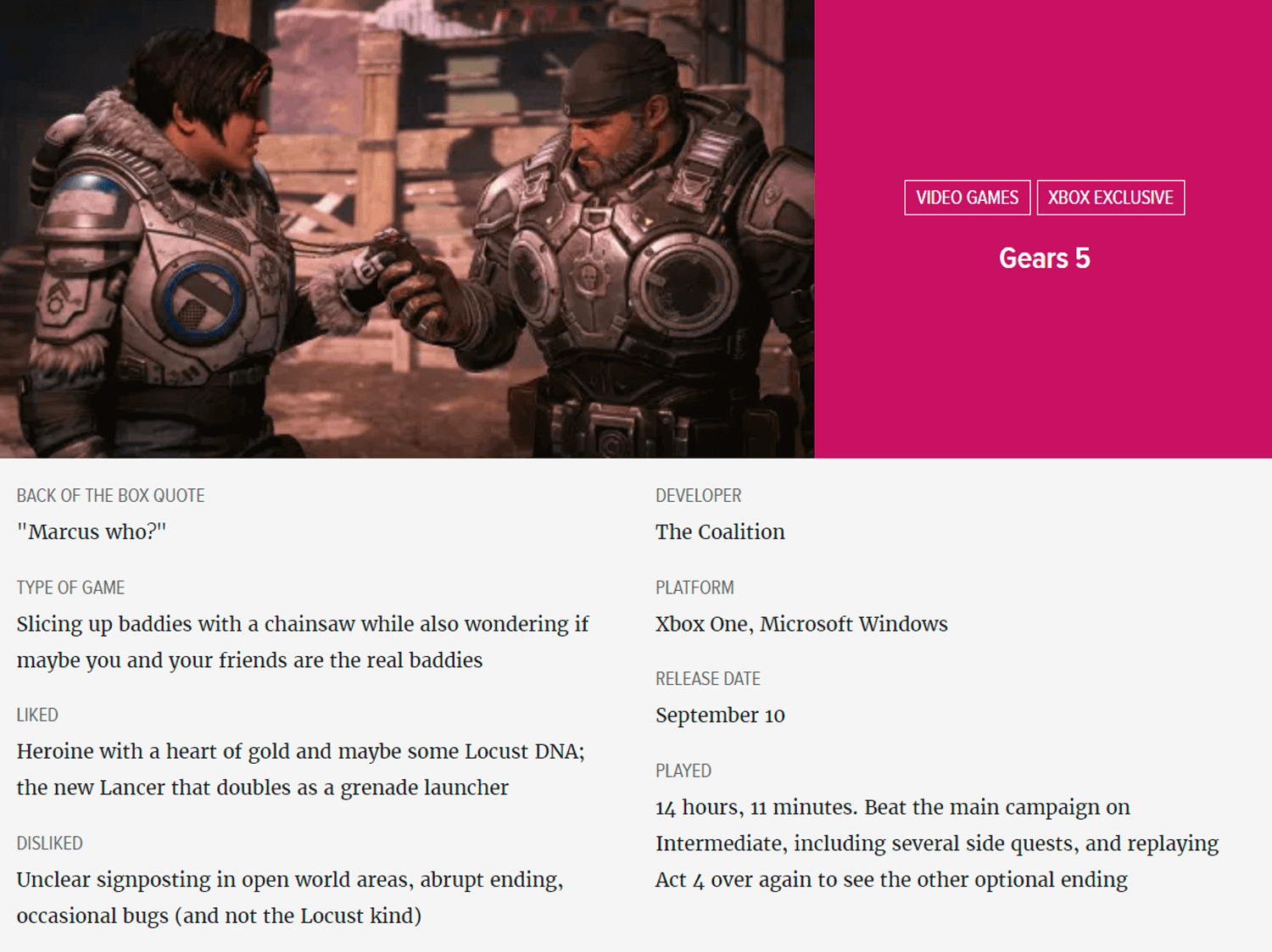 Gears 5 has the longest and most ambitious campaign that Gears of War has ever done and, for the most part, that ambition pays off. In a series first, the story focuses on a female character, putting the player in a woman's shoes for the majority of the game. Gears 5 heroine Kait Diaz's journey of self-discovery introduces new complexities, both tactical and emotional, to the wider world of Gears.
Gears 5 has the longest and most ambitious campaign that Gears of War has ever done and, for the most part, that ambition pays off. In a series first, the story focuses on a female character, putting the player in a woman's shoes for the majority of the game. Gears 5 heroine Kait Diaz's journey of self-discovery introduces new complexities, both tactical and emotional, to the wider world of Gears.
Like previous Gears games, Gears 5 is still an over-the-shoulder cover shooter about slicing and shooting humanoid reptiles with a chainsaw gun on a not-quite-like-Earth planet named Sera. This entry in the series expands that paradigm in several ways, beyond its focus on a very different heroine or the dropping of "of War" from the title. In another series first, Gears 5 includes role-playing elements. For example, the game now has an ability skill tree for the helper robot that accompanies the game's heroes. As in previous games, this bot helps unlock doors and marks points of interest on the game's directional compass, but now he also has offensive and defensive skills, including a zapper and a shield. These skills can be leveled up and refined using tech collected throughout the game.
Gears 5 also distinguishes itself from former Gears campaigns by including two open world areas to explore. The campaign's second act is set in an icy landscape, and the third act is in a red desert. Both areas contain optional side quests, some of which yield special tech upgrades that can max out the helper bot's skills to their full potential.
In yet another first, the game includes one major choice that players will make late in the game that can trigger different endings. The Gears of War series, famous for its linearity, just got a lot more complicated.
The Gears of War series started on the Xbox 360 back in 2006 and was made by a team at Epic Games for its first few releases. The spin-off Gears of War: Judgment was largely made by People Can Fly, and then the franchise was sold to Microsoft, which built a new studio, The Coalition, to make new Gears games. Its debut title was 2016's Gears of War 4, which deserved the damning praise of being just fine, crouching behind cover, if you will. This new entry arrives with a refreshing attempt to make the series finally advance once more.
(NOTE: Gears 5 includes a campaign, competitive multiplayer, a co-op horde mode and a new co-op escape mode. This review only covers the campaign, which is the one part of the game that we could play in depth prior to the game's release. We'll have more to say about its multiplayer once the game is being widely played online.)

The red desert of Act 3.
The meaty heart of Gears 5 is packed with more of the best of Gears of War. It's still a gorgeous series of shooting galleries with a collection of satisfying weapons. The game's stunning set pieces range from a dilapidated Broadway-esque theatre stage, to an abandoned science lab full of dimly lit hallways, to a rocket launch site in the middle of a desert beset by lightning storms. Its heroes still have the same pleasantly heavy feel to them as they lumber behind cover in their linebacker-esque body armor, lifting their beefy arms to spray machine gun fire or to rev up that good old chainsaw bayonet. Those heroes still fight off waves upon waves of the various monsters that make up the Locust Horde, from the gun-toting Drones to the oversized Scions. And like prior Gears games, Gears 5 intersperses all of that with a story about how the world's politics affect a core group of soldiers, who also happen to be lifelong friends.
The featured collection of friends has changed a couple of times since Gears of War 3. The original Gears of War trilogy's protagonist, Marcus Fenix, has proven to be a tough act to follow. John DiMaggio's voice work and the early games' writing solidified Fenix as an icon, a gruff guy with a gooey center and a too-long list of dead loved ones. Gears of War: Judgment tried to pass the torch to comic relief character Baird, which went about as well as that ill-fated Friends spin-off about Joey. Gears of War 4 tried for a Marcus 2.0 in the form of the hero's son, JD Fenix, whose total lack of charm proved that being a Gears hero takes more than huge trapezius muscles.
In Gears of War 4, as in other Gears games, JD ran through the game with a squad of allies that other players could control. One of his allies was Kait, who anyone playing the campaign solo would only experience as a supporting character. But that game's cliffhanger ending---Diaz receiving a family heirloom that features the symbol of the enemy Locust faction---was all about her and solidified her status as the new Gears generation's most interesting character.
At first, Gears 5 comes off as another JD adventure. In Act 1, the player inhabits JD Fenix, with his buddy Del Walker available for a second player and the helper bot, called Jack, available for a third. (The computer controls them otherwise.) At the start of Act 2, the campaign changes focus. After that, it's all about Kait.
Kait Diaz is the first Gears protagonist to successfully reorient the gravitational pull of the series away from Marcus Fenix. Marcus is in this game, too, but unlike his former cameos in Judgment and Gears 4, he doesn't steal every scene he's in. The new heroine's grip is too strong for that and shows that this franchise really can be bigger than Marcus Fenix, or at least be good even when he's on the sidelines. Early in Act 2 of Gears 5, Kait abandons her duties as a soldier, striking out on her own to learn more about her mysterious heritage; she's still accompanied by Del, whose personal allegiance has been split by the growing rift between his two best friends, JD and Kait.
Gears of War 4's campaign was sparse on story; the most relevant plot point for Gears 5 involved Diaz's necklace, which, along with other events in that game, suggested she has some ancestral connection to the Locusts---perhaps even to Queen Myrrah, the surprisingly human-looking and now deceased leader of the Locust Horde.
The origins of Myrrah, the background of the Locust and even things like the relationship between JD and his father, all have made Gears more than just another shooter. Across a half-dozen games, the series has built up some lore and used it to connect to more grounded and realistic themes of power and politics and the aggression of competing societies. The Locust have been presented intermittently as a merciless army, as a resistance to human colonizers, and as the victims of human experimentation. Their existence and the wars in Gears of War have long involved a controversial fuel source called Imulsion. It makes sense, then, that series creator Cliff Bleszinski cited the Gulf War as one of the historical inspirations for Gears of War.
Gears 5 continues in this vein, offering glimpses at the big picture political conflicts that drive the game's heroes as well as the personal journeys of the handful of soldiers in the game. In the big picture, the human government has become increasingly authoritarian in the face of the Locust threat, even as the Horde uses its hive mind capabilities to achieve a level of unity that human fascism could only ever dream of achieving. In the smaller picture, Kait is still mourning the death of her mother, Locust heritage or no.
The emotional truth of Kait's story is echoed in the game's mechanics. Kait is lost and overwhelmed, and so it makes sense that this is the first Gears of War game that allows the player to get lost as well. In the game's open world sections the helper bot Jack will point out potential locations of interest on the compass, but the landscape's dips, valleys, and pathways must be discovered by the player, or defogged on a map you can only see when you pause. Kait and Del navigate these new worlds on a skiff, a futuristic cross between a jet-ski and a sailboat that can be directionally controlled by rotating a balloon that billows out in front of it.

The snowy vistas of Act 2.
The other theme of Gears 5, which is also echoed in its mechanics, is the idea of supposed allies switching sides. Kait and her allies have gone from rebelling against the government in parts of the last game to fighting for it. As in Gears of War 4, human soldiers continue to use military androids to assist them in their efforts; in Gears 5, some of these androids get corrupted by the Locust and turn against the humans. Fighting these corrupt androids is a lot spookier and more satisfying than the occasional robot battles in Gears of War 4. They lumber toward you, shoulders hunched unevenly, then speed up in one final lurching gasp of unsettling energy. At one point I watched a robot start to slouch out of a room only to double back and heave itself across a countertop to get me.
Later, you receive a skill for your bot that allows you to take over the mind of most of the enemies you face, converting them to the human side of the fight for a few seconds. This works best on robot enemies, but it also works on certain Locust enemies. It feels chilling to take over the mind of an enemy, making them turn around and gun down their comrades, knowing that in a few seconds they'll snap back out of it and you'll have to kill them yourself.
The theme of switching sides and sowing mistrust infuses the game's cutscenes and dialogue. Kait's ownership of the Locust necklace makes JD suspicious of her. JD encourages Del to be suspicious as well, casting Del's decision to accompany Kait throughout the game in a more ominous light. Kait keeps expecting him to turn on her, and he seems to worry she'll do the same.
There are also other political debates that go beyond the central human-Locust conflict. Within Gears 5's world, not everyone agrees with the aggressive militarization that the human government has enacted in response to the Locust threat; this has resulted in protests, at least one of which got shut down by force before the events of this game. Some Gears 5 characters believe that the use of military force against these protestors was fair. Others disagree. It's not ever made clear what really happened; it's just one more rift in a series of political and emotional rifts between the characters. At one point, as you walk as Kait through a remote settlement, children run away from you, mocking you and calling you a fascist.
Kait Diaz is a heroine who embodies these rifts. As she learns more about her Locust origins, she increasingly fears getting her mind taken over by the beings that she sees as her enemy. A series of strange symptoms have already begun for her at the game's outset; she gets what she calls headaches, but they're more like Locust-themed visions.
That's not the only part of her heritage that appears to differentiate her from JD Fenix, the blue-eyed son of a famous war hero. Like Marcus and JD, Kait also has light eyes, but unlike them, she has darker skin.The fictional planet of Sera doesn't have the same counties or history as the planet Earth, but with Latinx actors Jimmy Smits and Justina Machado voicing the characters of Kait's uncle and mother, it seems that Kait is not intended to be perceived as a white character (although she is voiced by white actress Laura Bailey). Kait's life experiences have also been very different from former protagonists Marcus and JD. She didn't grow up in a mansion in a military family; she grew up in the desert among outsiders who don't trust the government or the military, and her decision to join was seen as a betrayal of her upbringing. The frosting on top of Kait's multifaceted identity is her haircut in Gears 5: short on one side, long on the other, a half-and-half mix of butch and femme presentation.

Gears 5's campaign is stuffed with complicated new ideas, but at times, it struggles in its delivery. In contrast to the too-sparse Gears 4, this game intersperses its action sequences with very long cutscenes showing the introduction of several plot points, but not all of them get resolved or explained. The two different possible endings for the game both feel oddly abrupt, almost like there's a scene missing somewhere in Act 3 or 4 in which Kait actually addresses the rifts that have grown between her and her friends. The game's new open worlds also introduce the idea of choice, but in practice, the available choices aren't that clear. I occasionally stumbled into areas I wasn't supposed to be in, facing a series of locked doors until I doubled back and saw whatever narrative set-piece I needed to witness in order to unlock them.
The helper bot's panoply of combat-related abilities seem useful in theory, but in the chaos of battle, many of them aren't practical. I used the Shock Trap ability most often; it's an electronically-charged mine that you can set and forget. The bot excels more at support capabilities; Jack can retrieve weapons or ammo and even revive far-off teammates. Eventually, Jack gets an amazing shield ability, but not until you're almost at the very end of the game. All of this is only helpful if you remember that Jack exists at all, which is not second nature in the middle of a firefight, especially since past Gears games have never had such a hands-on helper bot with abilities like these before.

Gears 5 on PC has a few bugs that hopefully will get patched on release day, or in the near future. Multiple times, I would clear an entire area of a huge wave of enemies, only to have the game not register that I had actually cleared the area. Sometimes if I just ran around the empty room for a few minutes, the game would figure out that everybody was dead, but other times, the only option was to restart from the last checkpoint and clear the entire wave all over again. At least three times over the course of my play-through, my gaming PC blue-screened and shut down the entire game. During the Act 2 boss, by far the most difficult battle of the game, my AI companion insisted on picking up a metal pipe instead of a gun. I could have beaten that boss a hell of a lot faster if he had managed to pick up any of the dozens of guns lying around in that room. Act 3 and 4 felt easier than the first half of the game, particularly the final bosses of those chapters. Even more strangely, the most shocking and climactic story reveals happen during Act 2, suggesting that it would have worked better as the actual ending of the game. (For comparison's sake, my colleague Stephen, who has played late into Act 2 on an Xbox One, hasn't hit any bugs or needed to do any restarts.)
Despite those issues, Gears 5 is a strong entry in a series that had been undeniably flagging on its campaigns. Gears 5 has a few too many new ideas, both narrative and mechanical, but its choice to put Kait at its center helps carry the game over its rougher spots. Gears 5 doesn't top the original Gears trilogy, but it's easily my favorite of the latter-day Gears games.
The creative team for this series has changed a lot since its beginnings. The world around Gears has changed, too. Gears 5 seems like a reflection of those changes. It's a game that further complicates its world and stars a more complex hero. It's still a game with a chainsaw gun, but now, those chainsaw guns can have a grenade launcher attached. Sometimes, change is good.
